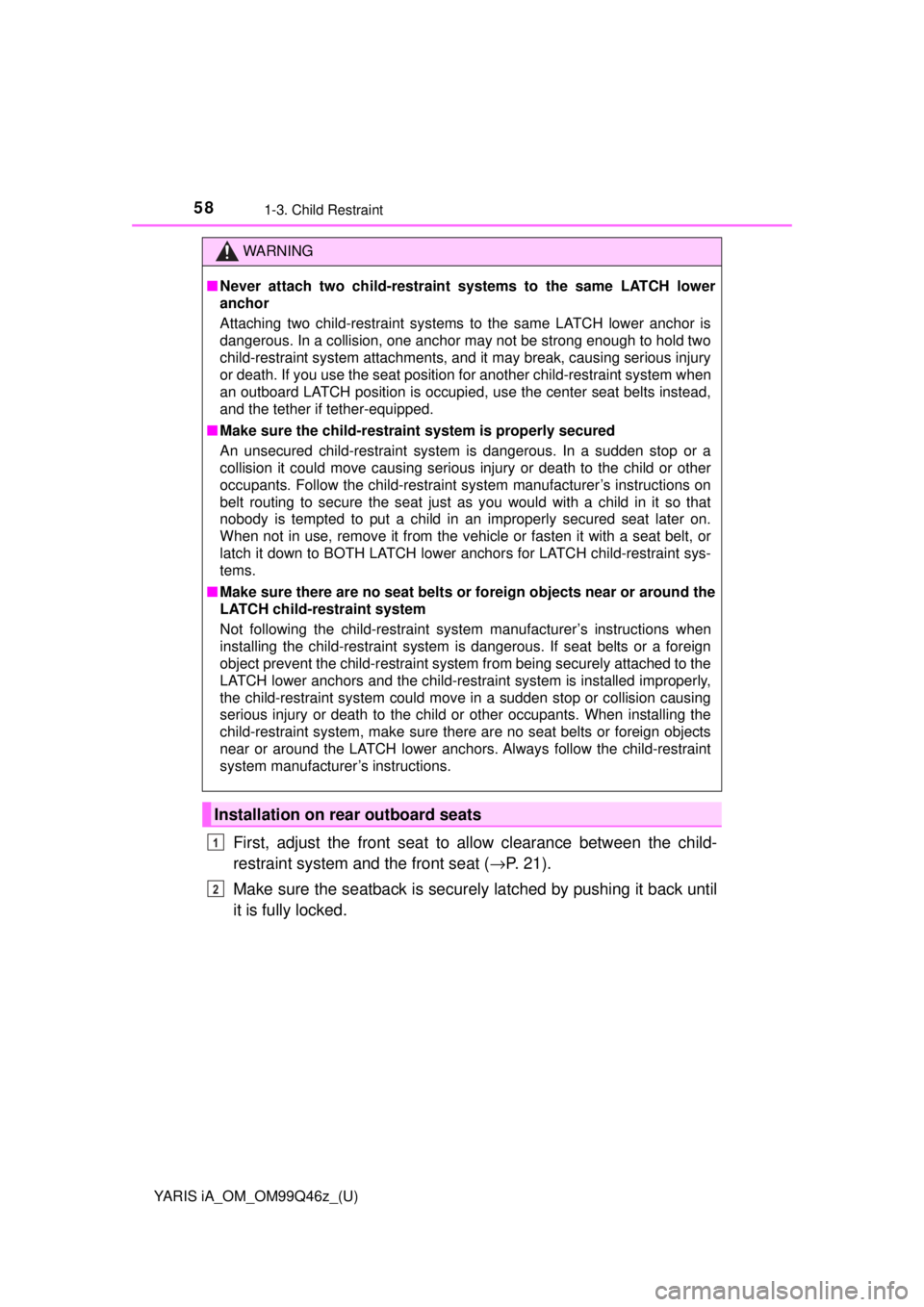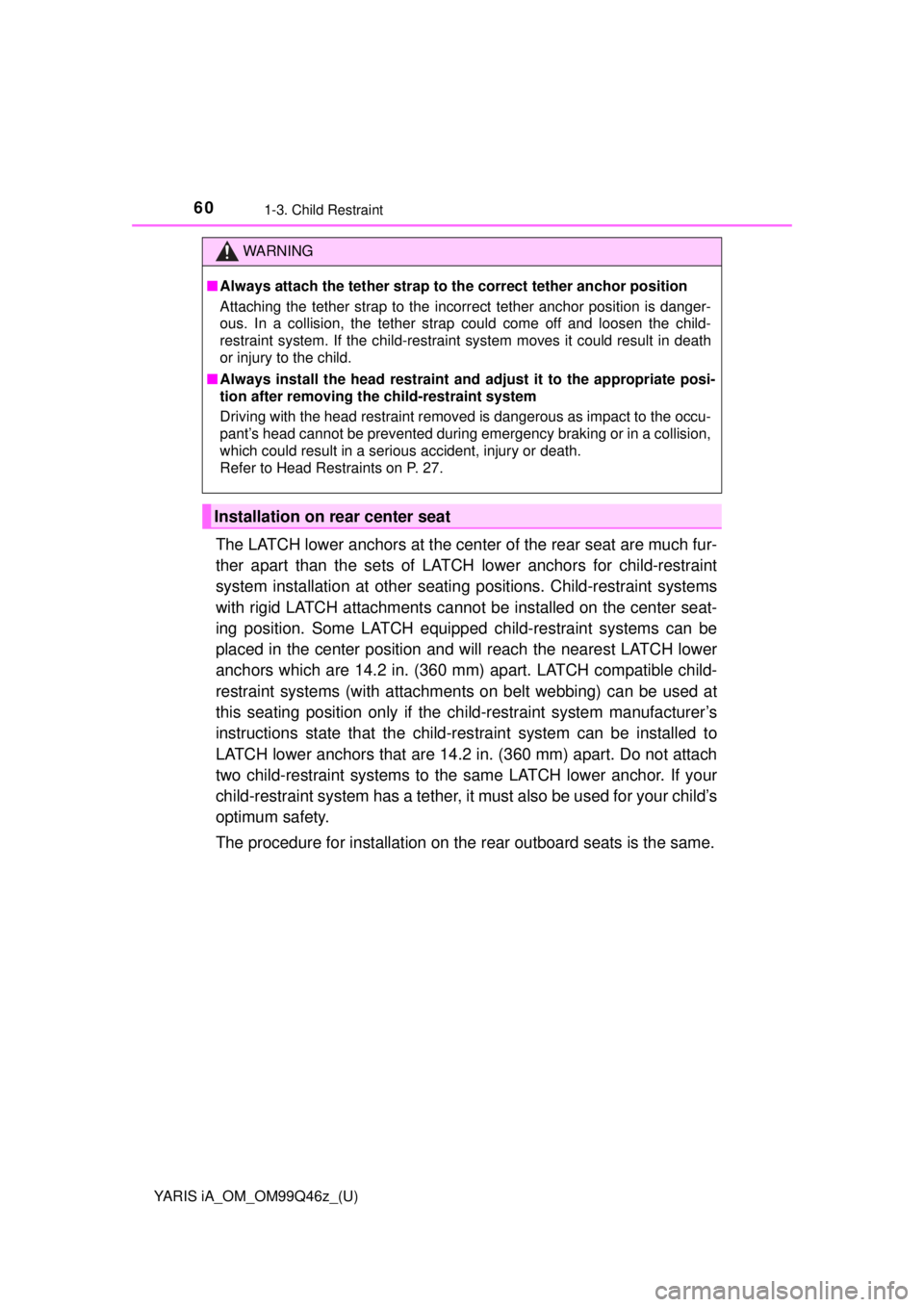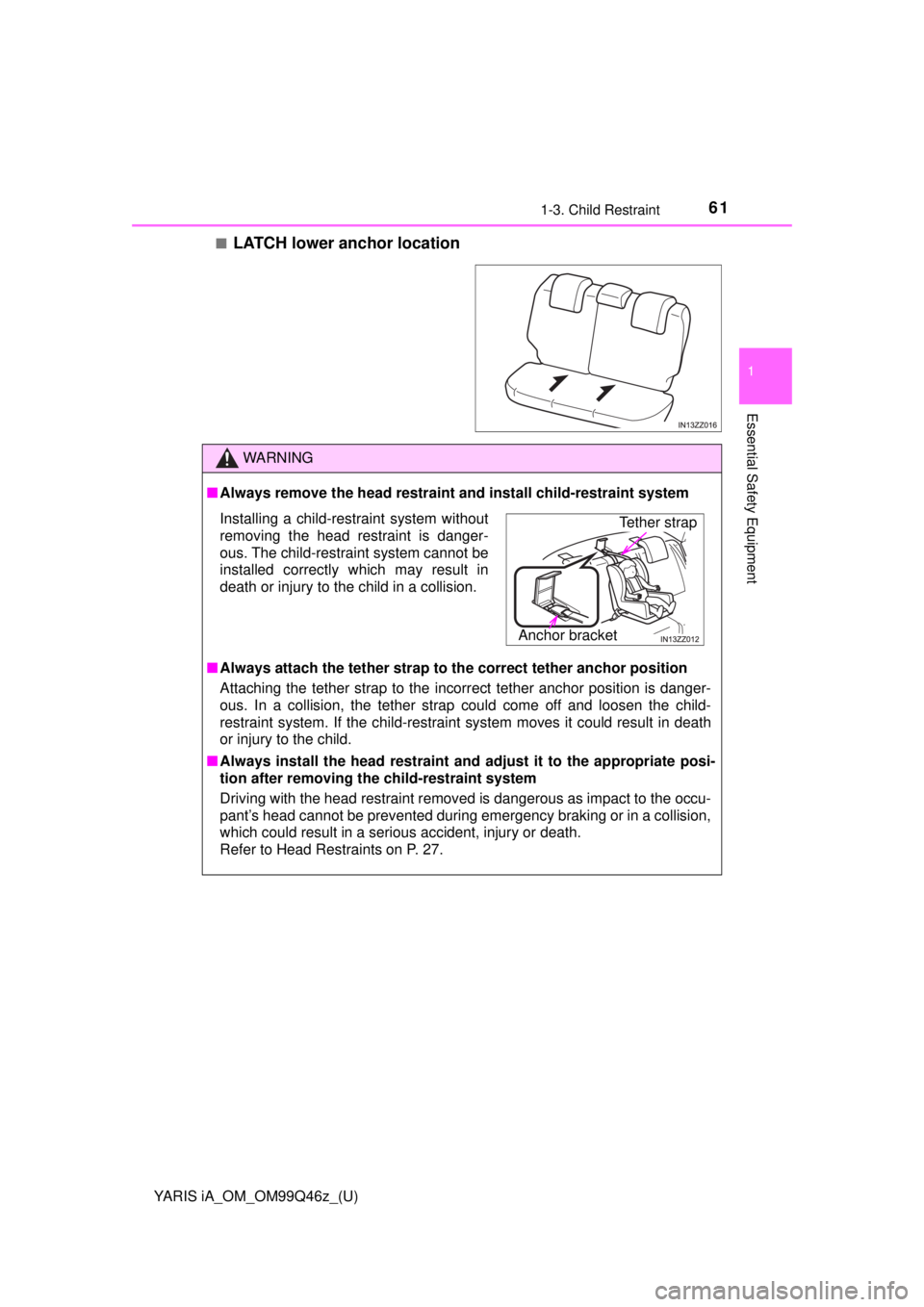2018 TOYOTA YARIS iA warning
[x] Cancel search: warningPage 58 of 576

58
YARIS iA_OM_OM99Q46z_(U)
1-3. Child Restraint
First, adjust the front seat to allow clearance between the child-
restraint system and the front seat ( →P. 2 1 ) .
Make sure the seatback is securely latched by pushing it back until
it is fully locked.
WARNING
■ Never attach two child-restraint systems to the same LATCH lower
anchor
Attaching two child-restraint systems to the same LATCH lower anchor is
dangerous. In a collision, one anchor may not be strong enough to hold two
child-restraint system attachments, and it may break, causing serious injury
or death. If you use the seat position for another child-restraint system when
an outboard LATCH position is occupied, use the center seat belts instead,
and the tether if tether-equipped.
■ Make sure the child-restraint system is properly secured
An unsecured child-restraint system is dangerous. In a sudden stop or a
collision it could move causing serious injury or death to the child or other
occupants. Follow the child-restraint system manufacturer’s instructions on
belt routing to secure the seat just as you would with a child in it so that
nobody is tempted to put a child in an improperly secured seat later on.
When not in use, remove it from the vehicle or fasten it with a seat belt, or
latch it down to BOTH LATCH lower anchors for LATCH child-restraint sys-
tems.
■ Make sure there are no seat belts or foreign objects near or around the
LATCH child-restraint system
Not following the child-restraint system manufacturer’s instructions when
installing the child-restraint system is dangerous. If seat belts or a foreign
object prevent the child-restraint system from being securely attached to the
LATCH lower anchors and the child-restraint system is installed improperly,
the child-restraint system could move in a sudden stop or collision causing
serious injury or death to the child or other occupants. When installing the
child-restraint system, make sure there are no seat belts or foreign objects
near or around the LATCH lower anchors. Always follow the child-restraint
system manufacturer’s instructions.
Installation on rear outboard seats
1
2
Page 59 of 576

YARIS iA_OM_OM99Q46z_(U)
591-3. Child Restraint
1
Essential Safety Equipment
Expand the open seams on the
rear of the seat bottom slightly
to verify the locations of the
LATCH lower anchors.
The markings above the LATCH
lower anchors indicate the loca-
tions of the LATCH lower anchors
for the attachment of a child-
restraint system.
Remove the head restraint.
Refer to Head Restraints on P. 27.
Secure the child-restraint system using BOTH LATCH lower
anchors, following the child-restraint system manufacturer’s instruc-
tion. Pull on the child-restraint to be sure both anchors are
engaged.
If your child-restraint system came equipped with a tether, that
means it is very important to pr operly secure the tether for child
safety. Please carefully follow the child-restraint system manufac-
turer’s instructions when installing tethers.
3
WARNING
■ Use the tether and tether anchor only for a child-restraint system
Using the tether or tether anchor to secure anything but a child-restraint
system is dangerous. This could weaken or damage the tether or tether
anchor and result in injury.
■ Always remove the head restraint and install child-restraint system
4
5
6
Installing a child-restraint system without
removing the head restraint is danger-
ous. The child-restraint system cannot be
installed correctly which may result in
death or injury to the child in a collision.
Anchor bracket
Tether strap
Page 60 of 576

60
YARIS iA_OM_OM99Q46z_(U)
1-3. Child Restraint
The LATCH lower anchors at the center of the rear seat are much fur-
ther apart than the sets of LATCH lower anchors for child-restraint
system installation at other seating positions. Child-restraint systems
with rigid LATCH attachments cannot be installed on the center seat-
ing position. Some LATCH equipped child-restraint systems can be
placed in the center position and will reach the nearest LATCH lower
anchors which are 14.2 in. (360 mm) apart. LATCH compatible child-
restraint systems (with attachments on belt webbing) can be used at
this seating position only if the ch ild-restraint system manufacturer’s
instructions state that the child-res traint system can be installed to
LATCH lower anchors that are 14.2 in. (360 mm) apart. Do not attach
two child-restraint systems to the same LATCH lower anchor. If your
child-restraint system has a tether, it must also be used for your child’s
optimum safety.
The procedure for installation on the rear outboard seats is the same.
WARNING
■ Always attach the tether strap to the correct tether anchor position
Attaching the tether strap to the incorrect tether anchor position is danger-
ous. In a collision, the tether strap could come off and loosen the child-
restraint system. If the child-restraint system moves it could result in death
or injury to the child.
■ Always install the head restraint and adjust it to the appropriate posi-
tion after removing the child-restraint system
Driving with the head restraint removed is dangerous as impact to the occu-
pant’s head cannot be prevented during emergency braking or in a collision,
which could result in a serious accident, injury or death.
Refer to Head Restraints on P. 27.
Installation on rear center seat
Page 61 of 576

YARIS iA_OM_OM99Q46z_(U)
611-3. Child Restraint
1
Essential Safety Equipment
■LATCH lower anchor location
WARNING
■Always remove the head restraint and install child-restraint system
■ Always attach the tether strap to the correct tether anchor position
Attaching the tether strap to the incorrect tether anchor position is danger-
ous. In a collision, the tether strap could come off and loosen the child-
restraint system. If the child-restraint system moves it could result in death
or injury to the child.
■ Always install the head restraint and adjust it to the appropriate posi-
tion after removing the child-restraint system
Driving with the head restraint removed is dangerous as impact to the occu-
pant’s head cannot be prevented during emergency braking or in a collision,
which could result in a serious accident, injury or death.
Refer to Head Restraints on P. 27.
Installing a child-restraint system without
removing the head restraint is danger-
ous. The child-restraint system cannot be
installed correctly which may result in
death or injury to the child in a collision.
Anchor bracket
Tether strap
Page 64 of 576

64
YARIS iA_OM_OM99Q46z_(U)
1-4. SRS Air Bags
WARNING
■Seat belts must be worn in air bag equipped vehicles
Depending only on the air bags for protection during an accident is danger-
ous. Alone, air bags may not prevent serious injuries. The appropriate air
bags can be expected to inflate only in the first accident, such as frontal,
near frontal or side collisions or roll-over accidents that are at least moder-
ate. Vehicle occupants should always wear seat belts.
■ Children should not ride in the front passenger seat
Placing a child, 12 years or under, in the front seat is dangerous. The child
could be hit by a deploying air bag and be seriously injured or even killed. A
sleeping child is more likely to lean against the door and be hit by the side
air bag in moderate collision to the front-passenger side of the vehicle.
Whenever possible, always secure a child 12 years and under on the rear
seats with an appropriate child-restraint system for the child’s age and size.
■ Never use a rear-facing child-restra int system in the front seat with an
air bag that could deploy
■ Do not sit too close to the dr iver and front passenger air bags
Sitting too close to the driver and fr ont passenger air bag modules or plac-
ing hands or feet on them is extremely dangerous. The driver and front pas-
senger air bags inflate with great force and speed. Serious injuries could
occur if someone is too close. The driver should always hold onto only the
rim of the steering wheel. The front seat passenger should keep both feet
on the floor. Front seat occupants should adjust their seats as far back as
possible and always sit upright against the seatbacks with seat belts worn
properly.
Rear-facing child-restraint systems on
the front seat are particularly dangerous
even though you may feel assured that a
front passenger air bag will not deploy
based on the fact that the front passen-
ger air bag deactivation indicator light
illuminates. The child-restraint system
can be hit by a deploying air bag and
moved violently backward resulting in
serious injury or death to the child.
Page 65 of 576

YARIS iA_OM_OM99Q46z_(U)
651-4. SRS Air Bags
1
Essential Safety Equipment
WARNING
■Sit in the center of the seat and wear seat belts properly
Sitting too close to the side air bag modules or placing hands on them, or
sleeping up against the door or hanging out the windows is extremely dan-
gerous. The side and curtain air bags inflate with great force and speed
directly expanding along the door on the side the car is hit. Serious injury
could occur if someone is sitting too close to the door or leaning against a
window, or if rear seat occupants grab the sides of the front seatbacks. Give
the side and curtain air bags room to work by sitting in the center of the seat
while the vehicle is moving with seat belts worn properly.
■ Do not attach objects on or around the area where driver and front pas-
senger air bags deploy
Attaching an object to the driver and front passenger air bag modules or
placing something in front of them is dangerous. In an accident, an object
could interfere with air bag inflation and injure the occupants.
■ Do not attach objects on or around the area where a side air bag
deploys
Attaching objects to the front seat in such a way as to cover the outboard
side of the seat in any way is dangerous. In an accident the object could
interfere with the side air bag, which inflates from the outboard side of the
front seats, impeding the added protection of the side air bag system or
redirecting the air bag in a way that is dangerous. Furthermore, the bag
could be cut open releasing the gas.
Do not hang net bags, map pouches or backpacks with side straps on the
front seats. Never use seat covers on the front seats. Always keep the side
air bag modules in your front seats free to deploy in the event of a sid\
e colli-
sion.
■ Do not attach objects on or arou nd the area where a curtain air bag
deploys
Attaching objects to the areas where the curtain air bag activates such \
as
on the windshield glass, side door glass, front and rear window pillars and
along the roof edge and assist grips is dangerous. In an accident the object
could interfere with the curtain air bag, which inflates from the front and rear
window pillars and along the roof edge, impeding the added protection of
the curtain air bag system or redirecting the air bag in a way that is danger-
ous. Furthermore, the bag could be cut open releasing the gas.
Do not place hangers or any other objects on the assist grips. When hang-
ing clothes, hang them on the coat hook directly. Always keep the curtain air
bag modules free to deploy in the event of a side collision or roll-over acci-
dent.
Page 66 of 576

66
YARIS iA_OM_OM99Q46z_(U)
1-4. SRS Air Bags
WARNING
■Do not touch the components of the supplemental restraint system
after the air bags have inflated
Touching the components of the supplemental restraint system after the air
bags have inflated is dangerous. Immediately after inflation, they are very
hot. You could get burned.
■ Never install any front-end equipment to your vehicle
Installation of front-end equipment, such as frontal protection bar (kangaroo
bar, bull bar, push bar, or other similar devices), snowplow, or winches, is
dangerous. The air bag crash sensor system could be affected. This could
cause air bags to inflate unexpectedly, or it could prevent the air bags from
inflating during an accident. Front occupants could be seriously injured.
■ Do not modify the suspension
Modifying the vehicle suspension is dangerous. If the vehicle’s height or the
suspension is modified, the vehicle will be unable to accurately detect a col-
lision or roll-over accident resulting in incorrect or unexpected air bag
deployment and the possibility of serious injuries.
■ To prevent false detection by the air bag sensor system, heed the fol-
lowing
● Do not use tires or wheels other than those specified for your Toyota:
Use of any tire or wheel other than those specified for your Toyota ( →P. 560)
is dangerous. Use of such wheels will prevent the vehicle’s accident detec-
tions system from accurately detecting a collision or roll-over accident result-
ing in incorrect or unexpected air bag deployment and the possibility of
serious injuries.
● Do not overload your vehicle:
Overloading your vehicle is dangerous as it could prevent the air bag
crash sensor system from accurately detecting a collision or roll-over acci-
dent resulting in incorrect or unexpected air bag deployment and the pos-
sibility of serious injuries. The gross axle weight rating (GAWR) and the
gross vehicle weight rating (GVWR) for your vehicle are on the Motor
Vehicle Safety Standard Label on the driver’s door frame. Do not exceed
these ratings.
● Do not drive the vehicle off-road:
Driving your Toyota off-road is dangerous because the vehicle has not
been designed to do so. Driving the vehicle off-road could prevent the air
bag crash sensor system from accurately detecting a collision or roll-over
accident resulting in incorrect or unexpected air bag deployment and the
possibility of serious injuries.
Page 67 of 576

YARIS iA_OM_OM99Q46z_(U)
671-4. SRS Air Bags
1
Essential Safety Equipment
WARNING
■Do not modify a front door or l eave any damage unrepaired. Always
have your Toyota dealer inspect a damaged front door
Modifying a front door or leaving any damage unrepaired is dangerous.
Each front door has a side crash sensor as a component of the supplemen-
tal restraint system. If holes are drilled in a front door, a door speaker is left
removed, or a damaged door is left unrepaired, the sensor could be
adversely affected causing it to not detect the pressure of an impact cor-
rectly during a side collision. If a sensor does not detect a side impact cor-
rectly, the side and curtain air bags and the front seat belt pretensioner may
not operate normally which could result in serious injury to occupants.
■ Do not modify the supplemental restraint system
Modifying the components or wiring of the supplemental restraint system is
dangerous. You could accidentally activate it or make it inoperable. Do not
make any modifications to the supplemental restraint system. This includes
installing trim, badges, or anything else over the air bag modules. It also
includes installing extra electrical equipment on or near system components
or wiring. Your Toyota dealer can provide the special care needed in the
removal and installation of front seats. It is important to protect the air bag
wiring and connections to assure that the bags do not accidentally deploy,
and that the front passenger occupant classification system and the seats
retain an undamaged air bag connection.
■ Do not place luggage or other objects under the front seats
Placing luggage or other objects under the front seats is dangerous. The
components essential to the supplemental restraint system could be dam-
aged, and in the event of a side collision, the appropriate air bags may not
deploy, which could result in death or serious injury. To prevent damage to
the components essential to the supplemental restraint system, do not
place luggage or other objects under the front seats.
■ Do not operate a vehicle with dama ged air bag/seat belt pretensioner
system components
Expended or damaged air bag/seat belt pretensioner system components
must be replaced after any collision which caused them to deploy or dam-
age them. Only a trained Authorized Toyota Dealer can fully evaluate these
systems to see that they will work in any subsequent accident. Driving with
an expended or damaged air bag or pretensioner unit will not afford you the
necessary protection in the event of any subsequent accident which could
result in serious injury or death.